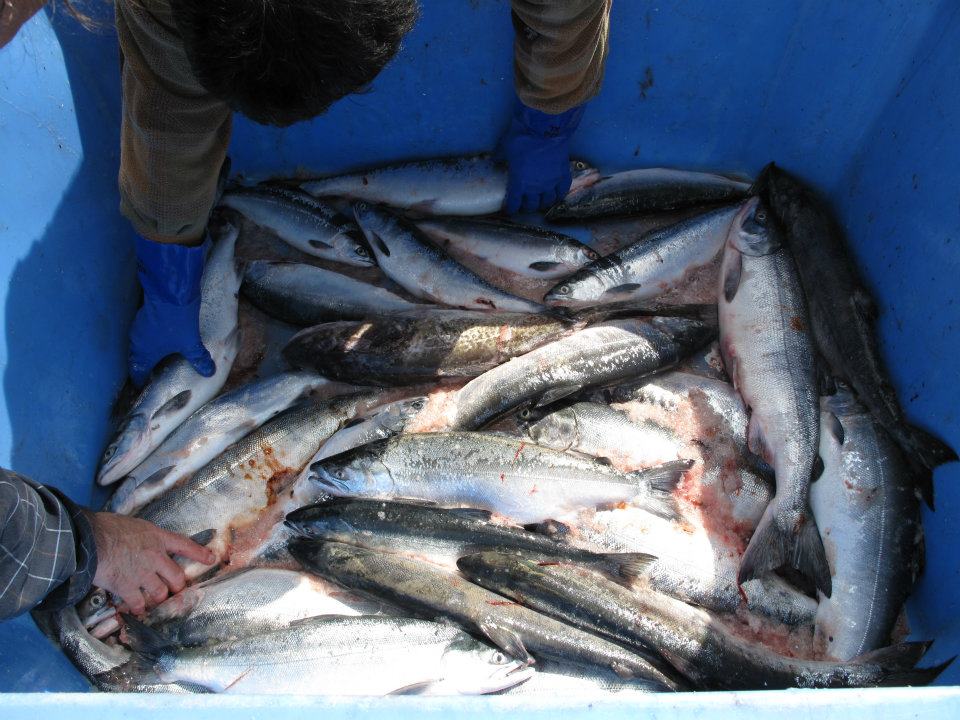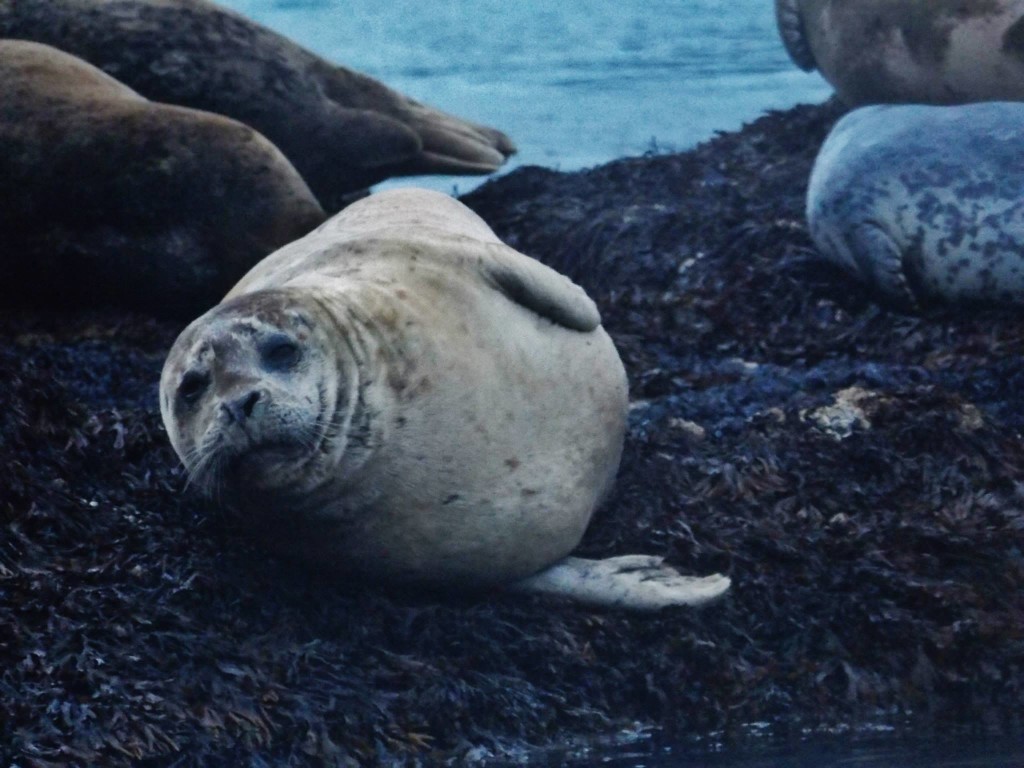Food from the Water
The State of Alaska manages three different types of fisheries on Kodiak Island: subsistence, sport fish, and commercial. While sport fishing is open to most individuals, commercial and subsistence fisheries are limited to certain types of fishing gear, specific areas, or to Alaska residents. The Alaska Department of Fish and Game maintains the chart, “What kind of fishery do you qualify for?” to help you determine which different fisheries you can participate in. Once you determine the kind of fisheries you are eligible for, then make sure you review the regulations for the specific areas you would like to fish and the species you want to catch. The seasons, harvest limits, methods and means, permitting, and reporting requirements vary widely.
Alaska residents, and only Alaska residents are eligible to participate in subsistence fisheries. Some subsistence fisheries require obtaining a permit issued by the Alaska Department of Fish and Game before participating in the fishery. Make sure to check with the Kodiak Fish and Game Department to find out if you need a subsistence permit before participating in Kodiak’s subsistence fisheries. Also, some waters are closed to subsistence fishing so make sure you double check the fishing regulations before you fish.

Salmon
All five species of Pacific salmon – King (Chinook), sockeye, coho, pink, and chum salmon – are found in the waters in and around Kodiak Island. Within the Kodiak Management Area, sockeye salmon are the most subsistence harvested salmon species. All individuals harvesting subsistence salmon must have a state permit. The permits allow individual fishers to harvest 25 salmon for their own use plus 25 additional salmon for each member of the permit holder’s household. An additional permit can be obtained if the fisher could demonstrate a need for more fish.
Generally, subsistence salmon fishing is open year-round, with seasonal conditions placed on the use of commercial purse seine vessels when subsistence fishing. Federal regulations allow subsistence fishing 24 hours per day, while state regulations only allow subsistence fishing to occur between 6:00 AM and 9:00 PM.
Under state regulations, legal gear for subsistence salmon harvest in the Kodiak Management Area include gillnets and seines. State subsistence fishers are required to physically attend their net while fishing and should always have a valid subsistence salmon permit on when while they are fishing. Harvested fish should be recorded on the permit before concealing them from plain view, or transporting them from the harvest area. For further information about state subsistence salmon regulations including specifics on gear types and amendments to the harvest seasons, please visit the State of Alaska’s Department of Fish and Game website for the Kodiak Subsistence Salmon Fishing Regulations.
Federal regulations generally mirror the state regulations summarized above but also include rod and reel as legal harvest gear (in addition to gillnets and seines).
Other Freshwater Fish including Rainbow Trout, Dolly Varden, Steelhead, and Grayling
Wild populations of steelhead, rainbow trout, and Dolly Varden populate the rivers, streams, and lakes throughout the Kodiak archipelago. In addition to wild populations of salmon, steelhead, rainbow trout and Dolly Varden, the Alaska Department of Fish and Game stocks a number of roadside lakes with hatchery rainbow trout fingerlings. The Kodiak Island Freshwater Sport Fishing Regulations detail the regulations for these fisheries.
Ground fish
The marine waters around Kodiak have a great variety of ground fish species such as Pacific cod, lingcod, pollock, and different types of flounders and rockfish. Black, dusky, and yellow eye rock fish are the most commonly caught rockfish around the archipelago. There are some restrictions on subsistence lingcod and rockfish (black, dusky and yellow eye). There are some state and federal restrictions on subsistence lingcod and rockfish fishing in the Kodiak archipelago. Most groundfish fisheries off the Alaskan coast are managed by the National Marine Fisheries Service (NMFS) under management plans that were adopted by the North Pacific Fishery Management Council. For more information on the subsistence ground fish regulations, please visit the State of Alaska’s state subsistence regulations, or the federal subsistence ground fish laws and regulations.
Herring
Since 2002, subsistence herring harvests are included on the existing State of Alaska’s Kodiak Management Area salmon and crab subsistence permits. Regulations for the Kodiak subsistence herring fishery, including the sac roe fishery, are found within the Kodiak federal subsistence fishing regulations.
Shellfish
In the Kodiak area, harvested shellfish include king, Tanner, and Dungeness crab as well as shrimp and other miscellaneous shellfish including clams, cockles, mussels, chitons, octopuses, sea urchins, and others. While permits are required for the subsistence harvest of shellfish, harvesters only need one permit for both salmon and shellfish. Shellfish harvests are to be recorded on the back of the salmon permit. Harvest regulations include sex, size, and bag and possession limits for each of the shellfish species. For more information on the Kodiak area subsistence shellfish harvest regulations, please review the harvest regulations for the harvest of fish and shellfish on federal public lands and waters booklet and contact the Kodiak National Wildlife Refuge at (907) 487-2600. The Alaska Department of Fish and Game provides more information on the state subsistence shellfish fisheries and can be contacted at (907) 486-1825.
Halibut
Since 2003, all subsistence halibut fisheries are managed by the federal government. Regulations for subsistence halibut fishing in Alaska are adopted by the federal National Marine Fisheries Service based on recommendations from the federal North Pacific Fishery Management Council. Only rural Alaska residents qualify for the halibut subsistence fishery and before fishing eligible, rural Alaska residents must obtain a Subsistence Halibut Registration Certificate (SHARC). Eligible, rural Alaska resident include being a resident of a specifically-designated rural Alaska community or a member of a specifically-designated Alaska Native Tribe. For information please review the NOAA Subsistence Halibut Fishing in Alaska Information webpages or contact the National Marine Fisheries Service.
Even though the federal government manages the halibut subsistence fishery, the State of Alaska has adopted some regulations that affect sport fishing for halibut.
Seaweed
Throughout the State of Alaska, the Alaska Department of Fish and Game manages aquatic plants, which includes seaweed. Most of Alaska’s coastline is considered a “subsistence use area” so it is okay to harvest kelp for personal, noncommercial uses without a sport fishing license. Using dive gear to harvest kelp is prohibited by Alaska regulations. While there are no seasonal closures and no daily harvest limits, it is good practice to check with the Kodiak Alaska Department of Fish and Game office to make sure there are not any emergency closures before harvesting seaweed in the area. Please follow these guidelines when harvesting kelp:
- Harvest in manner that prevents dislodging the entire plant from the bottom, and prevents straining or breaking the plant.
- Do not cut the seaweed more than one foot below the surface of the water, and only keep the upper portion of the plant.
Sea Otters, Polar Bears, and Walruses
Contact the U.S. Fish and Wildlife Service Marine Mammal Management Office at (800) 362-5148 or (907) 786-3800 or by Email. Information is also available on the web at Fish and Wildlife Service.
Seals, Sea Lions, and Whales
Contact the Protected Resources Division of the National Marine Fisheries Service at (907) 586-7235. Information is also available on the web at NOAA.

